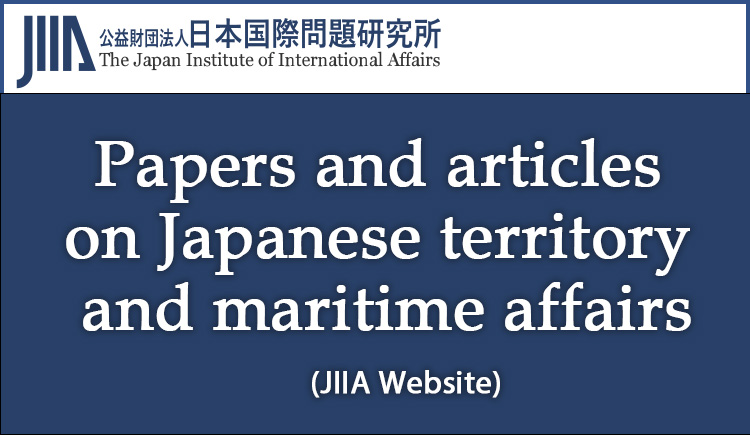The documents and materials published on this website were collected, researched, and prepared with advice from experts, as a part of a Government-commissioned project.
The contents of this website do not reflect the views of the Government.
The South China Sea and East China Sea
Column Maritime Delimitation and International Adjudication
Mariko Kawano (Professor, Faculty of Law, Waseda University)
*Adobe Acrobat Reader DC, provided by Adobe, is needed to view the PDF files. If you do not have the software, please download it from the linked site. Adobe Acrobat Reader DC
Introduction
Japan acceded to the United Nations Convention on the Law of the Sea (UNCLOS) in 1996 and enacted legislative measures concerning the territorial sea (TS), the exclusive economic zone (EEZ), and the continental shelf (CS) in accordance with the maritime regimes established under UNCLOS.1 Additionally, following the recommendations of the Commission on the Limits of the Continental Shelf (CLCS) in 2012, Japan adopted a Cabinet Order designating the continental shelf beyond 200 nautical miles as part of Japan’s continental shelf.2
In the maritime areas surrounding Japan, territorial sovereignty disputes over the Northern Territories and Takeshima remain unresolved. Furthermore, China and Taiwan claim sovereignty over the Senkaku Islands, which are Japan’s inherent territory. Against this backdrop, this paper examines the role that international courts and tribunals have played in settling disputes related to maritime delimitation (MD).
Note 1
Act on Territorial Waters and Contiguous Waters (Act No. 73 of 1996) and Act on the Exclusive Economic Zone and the Continental Shelf (Act No. 74 of 1996).
Note 2
The Shikoku Basin area was designated as part of Japan’s continental shelf by the 2014 Cabinet Order, which established the maritime area defined in Article 2, Item 2 of the Act on the Exclusive Economic Zone and the Continental Shelf. The Ogasawara Plateau area was subsequently designated as part of Japan’s continental shelf by the 2024 Cabinet Order, which amended part of the previous designation. Discussions with the United States regarding the Ogasawara Plateau area and the South Iwo Island area are ongoing (Cabinet Office, “Continental Shelf,” [in Japanese] https://www8.cao.go.jp/ocean/policies/tairikudana/tairikudana.html).
1. Meaning of Maritime Delimitation (MD)
UNCLOS recognizes the sovereignty of coastal states over the territorial sea (TS) (Article 2), as well as their sovereign rights and exclusive jurisdiction over the exclusive economic zone (EEZ) (Article 55) and the continental shelf (CS) (Article 76). It affirms the entitlement of coastal states to these maritime areas. The breath of TS is limited to 12 nautical miles (Article 3), while the EEZ extends up to 200 nautical miles (Article 57). A coastal state's sovereign rights and exclusive jurisdiction over the EEZ extend not only to the water column but also to the seabed and its subsoil (Article 56).
The CS is defined by two key elements: a distance of 200 nautical miles and the "natural prolongation of the land territory" (Article 76, paragraph 1). Under certain conditions, the CS may extend beyond 200 nautical miles (paragraphs 2–6 of the same article). Coastal states may submit information regarding the limits of their continental shelf beyond 200 nautical miles to the Commission on the Limits of the Continental Shelf (CLCS) and, following the Commission's recommendations, establish the outer limits of their continental shelf under domestic legislation (paragraphs 7 and 8 of the same article).
Maritime delimitation (MD) refers to the process of determining boundaries in maritime areas where the entitlements of two or more states overlap. Due to the significant expansion of maritime entitlements under UNCLOS, overlapping claims frequently arise between states with adjacent or opposite coastsr.3
Article 15 of UNCLOS addresses the delimitation of the territorial sea, stipulating that, in the absence of a special agreement between the states concerned, neither state may extend its territorial sea beyond the median line between them. This provision explicitly refers distance. Articles 74 (on EEZ MD) and 83 (on CS MD) contain nearly identical provisions. Both provisions prioritize settlement through mutual agreement between the parties (paragraph 1). However, if no agreement can be reached within a reasonable period of time, it is subject to dispute settlement procedures provided in Part XV of UNCLOS. Additionally, paragraph 4 of both articles emphasizes the need to respect any agreements in force between the states concerned regarding maritime delimitation.
During the drafting process of UNCLOS, states failed to reach agreement on specific standards and methods for maritime delimitation. Consequently, paragraph 1 of Articles 74 and 83 does not prescribe explicit delimitation rules but instead refers only to the "achievement of an equitable solution."
Note 3
V. Lowe and A. Sander, The Law of the Sea, Fourth Ed. (2022), pp. 300-302, and Y. Tanaka, International Law of the Sea, Fourth ed. (2023), p. 258.
2. MD Disputes and International Courts and Tribunals
(1) Dispute Settlement Mechanism of Part XV of UNCLOS
(ⅰ) Conditions for Recous to the Compulsory Procedures Entailing Binding Decisions under Section 2 of Part XV
A key feature of the dispute settlement system under UNCLOS is the compulsory procedures entailing binding decisions, as provided in Section 2 of Part XV. Article 286 sets out three conditions for referring a dispute to this mechanism: 1) There exist a dispute concerning the interpretation or application of UNCLOS; 2) No settlement has been reached by recourse to section 1; and 3) The dispute does not fall within the limitations and exceptions provided in section 3.4
Under Article 287, paragraph 1, a State Party to UNCLOS may declare its choice for one or more of the following dispute settlement procedures: (a) the International Tribunal for the Law of the Sea (ITLOS); (b) the International Court of Justice (ICJ); (c) an arbitral tribunal constituted in accordance with Annex VII; and (d) a special arbitral tribunal constituted in accordance with Annex VIII.
If both disputing parties have accepted the same procedure, the dispute shall be referred exclusively to the chosen forum unless otherwise agreed; however, if 1) the dispute is not covered by a declaration in force, 2) the parties have not accepted the same procedure, or 3) one or both parties have not made a declaration, the dispute shall be subject to the compulsory jurisdiction of an arbitral tribunal constituted in accordance with Annex VII (Article 287, paragraphs 3, 4, and 5).5
(ⅱ) Existence of a Dispute Concerning the Interpretation or Application of UNCLOS (First Condition)
A "dispute concerning the interpretation or application of a treaty" refers to a disagreement on a law or fact, a conflict of legal view or interests between the parties regarding the interpretation or application of specific treaty provision/provisions. A dispute concerning MD itself may constitute a dispute concerning the interpretation or application of Articles 15, 74, or 83 of UNCLOS and may fulfill the first condition under Article 286. However, disputes concerning MD often involve territorial disputes as their underlying issue, making them mixed disputes. When determining jurisdiction over mixed disputes, international tribunals have adopted two different approaches: one approach separates territorial disputes from maritime delimitation disputes, allowing courts and tribunals to exercise jurisdiction over maritime issues alone (e.g., South China Sea case6), while the other approach holds that jurisdiction is not excluded if the principal subject of the dispute concerns the interpretation or application of UNCLOS, even if a minor territorial dispute is involved (e.g., Chagos Marine Protected Area case7 and Kerch Strait case8).9
(ⅲ) Respect for the Settlement of Disputes by Means of Parties Own Choice (Second Condition)
The second condition under Article 286 ensures respect for the freedom of the parties to a dispute to settle the dispute by the means of their own choice, as provided in Articles 281 and 282. Before referring a dispute to the compulsory adjudication procedures under Section 2, the parties are also under an obligation to exchange views on the means for the settlement of the dispute (Article 283).10
In the Southern Bluefin Tuna case, the tribunal ruled that the final sentence of Article 281 means that even if the treaty between the disputing parties does not contain an explicit provision excluding the compulsory dispute settlement procedure under UNCLOS, such procedure is excluded if it is possible to confirm the intent of the parties for that purpose by interpreting the relevant treaty provisions.11 However, in the South China Sea case, the tribunal ruled that UNCLOS would not be excluded from compulsory adjudication unless there is an explicit provision stating so.12 The majority of legal scholars support the position taken in the South China Sea case.13
(ⅳ) Subject to Limitations and Optional Exceptions (Third Condition)
The third condition is that a dispute does not fall under the limitations set out in Article 297 or the optional exceptions provided in Article 298 under Section 3. Since reservations and exclusions are not permitted under UNCLOS to ensure the treaty's integrity (Article 309), concerns arose that some states might hesitate to become parties to UNCLOS due to the compulsory dispute settlement procedures in Section 2. To address these concerns, Section 3 was established to provide certain limitations and exceptions. Article 297 applies to all state parties, while Article 298 applies only to parties that have made a declaration under this provision. Disputes relating to MD, or those involving historic bays or titles fall within the scope of one of the optional exceptions, and a declaration excluding them would require acceptance of compulsory conciliation under Section 2 of Annex V (Article 298, paragraph 1(a)(i)).14
(2) Dispute Settlement Mechanism under Part XV of UNCLOS and the ICJ
Following the entry into force of UNCLOS, the ICJ has assumed two functions: jurisdiction under Article 36 of the ICJ Statute and jurisdiction as one of the options within the compulsory dispute settlement system under Part XV, Section 2 of UNCLOS.
For disputes between states that have accepted compulsory jurisdiction under Article 36, paragraph 2 of the ICJ Statute, Applicants may choose between the two compulsory adjudication mechanisms. In Japan’s 2015 declaration recognizing the jurisdiction of the ICJ as compulsory, a reservation was added regarding "disputes arising from, relating to, or connected with the investigation, conservation, management, or exploitation of living marine resources," explicitly limiting such disputes to settlement through compulsory dispute settlement procedures under Part XV of UNCLOS.
It should be noted that when a dispute is submitted under Article 36 of the ICJ Statute, the ICJ has jurisdiction over both territorial disputes and maritime delimitation (MD) disputes, meaning that the issue of mixed disputes—which arises in the compulsory adjudication system under Part XV, Section 2 of UNCLOS—does not come into question.15
Note 4
T. Treves, “Article 286,” in A. Proelss (ed.), United Nations Convention on the Law of the Sea: A Commentary (2017), pp. 1844-1849, N. Klein, Dispute Settlement in the UN Convention on the Law of the Sea (2005), pp. 31-52.
Note 5
T. Treves, “Article 287,” in Proelss, supra note 4, pp. 1849-1857.
Note 6
South China Sea Arbitration (Philippines v. China), Award of 2015, para. 157, 170, and 204.
Note 7
Chagos Marine Protected Area (Mauritius v. United Kingdom), Award of 18 March 2015, paras. 220-221.
Note 8
Dispute Concerning Coastal State Rights in the Black Sea, Sea of Azov, and Kerch Strait (Ukraine v. Russia) Award of 21 February 2020, paras. 157-161.
Note 9
Y. Tanaka, "Arbitration - The Chagos Marine Protected Area Case," in K. Morikawa et al. (eds.), 100 Cases of Public International Law, 3rd ed. (2021), p. 181, T. Treves, supra note 4, pp. 1847-1848, B. Oxman, “Courts and Tribunals: The ICJ, ITLOS, and Arbitral Tribunals,” in D. Rothwell et al. (eds.), The Oxford Handbook of the Law of the Sea (2016), p. 400, K. Kittichaisaree, The International Tribunal for the Law of the Sea (2021), pp. 94-99.
Note 10
A. Serdy, “Article 281,” “Article 282,” and “Article 283,” in Proelss, supra note 4, pp. 1820-1838.
Note 11
Southern Bluefin Tuna Arbitration (New Zealand v. Japan; Australia v. Japan), 4 August 2000, para. 57.
Note 12
South China Sea, supra note 6, para. 223.
Note 13
T. Treves, supra note 4, pp. 1848-1849.
Note 14
Ibid., pp. 1848, Oxman, supra note 9, pp. 403-408, A. Serdy, “Article 297,” and “Article 298,” in Proelss, supra note 4, pp. 1906-1932, Klein, supra note 4, pp. 125-315 (in particular, on maritime delimitation and historic title disputes, pp. 228–279).
Note 15
The ICJ rendered the judgments both on territorial and MD disputes in the following cases: Land, Island and Maritime Frontier Dispute (El Salvador/Honduras: Nicaragua intervening), Judgment of 11 September 1992, I.C.J. Reports 1992, p. 351; Land and Maritime Boundary between Cameroon and Nigeria (Cameroon v. Nigeria: Equatorial Guinea intervening), Judgment, I.C.J. Reports 2002, p. 303; Territorial and Maritime Dispute between Nicaragua and Honduras in the Caribbean Sea (Nicaragua v. Honduras), Judgment, I.C.J. Reports 2007, p. 659; Territorial and Maritime Dispute (Nicaragua v. Colombia), Judgment, I.C.J. Reports 2012, p. 624; and Maritime Delimitation in the Caribbean Sea and the Pacific Ocean (Costa Rica v. Nicaragua) and Land Boundary in the Northern Part of Isla Portillos (Costa Rica v. Nicaragua), Judgment, I.C.J. Reports 2018, p. 139. It should be noted that in the El Salvador/Honduras case, the Court was not requested to determine maritime delimitation but rather to assess the legal situation of the maritime spaces in question (El Salvador/Honduras, in this note, pp. 586–609, paras. 381–420, and pp. 616–617, para. 432(1)).
3. Development and Clarification of the Rules and Methods of International Law on MD through the Precedents of the International Courts and Tribunals
The precedents established in numerous international cases concerning maritime delimitation (MD) have contributed to the formulation of certain rules and methods for "achieving an equitable solution" as required under Articles 74(1) and 83(1) of UNCLOS in the context of EEZ and CS delimitation.
(1) Importance of Distance as the common element of CS and EEZ MDs in the MD under UNCLOS
The ICJ’s 1969 judgment in the North Sea Continental Shelf cases, the first precedent concerning continental shelf (CS) maritime delimitation (MD), had a significant impact on the drafting process of Articles 74 and 83 of UNCLOS. This case established key legal principles, including the ruling that Article 6 of the Geneva Shelf Convention did not constitute customary international law,16 as well as a detailed discussion of the methodologies and factors relevant to CS MD.17 Moreover, the Court’s judgment that "land dominates the sea"18 has been repeatedly cited in subsequent international cases.19
In the Tunisia/Libya and Libya/Malta cases, disputes over CS MD were referred to the ICJ while UNCLOS was being drafted and adopted.20 In the latter case, the ICJ rendered its judgment in 1985, after the adoption of UNCLOS, and made explicit reference to its provisions. The ICJ recognized that UNCLOS’s EEZ regime had become customary international law and confirmed that the case only concerned CS MD. However, the Court found that admitting that UNCLOS provides for two different but linked institutions of EEZ and CS, “greater importance must be attributed to elements, such as distance from the coast, which are common to both concepts.” It further stated that “, the institution of the exclusive economic zone, with its rule on entitlement by reason of distance, is shown by the practice of States to have become a part of customary law.”21
(2) Single Maritime Boundary (SMB)
Another factor that has increased the significance of distance criteria in UNCLOS maritime delimitation (MD) jurisprudence is the growing number of cases in which determination of a single maritime boundary (SMB) has been requested. Under UNCLOS, the EEZ (Part V) and the CS (Part VI) are distinct regimes, and in theory, separate delimitations are possible. However, from a practical standpoint, having different boundaries for the EEZ and CS is not feasible for effective maritime area utilization. As more cases involve requests for SMB determinations, the importance of distance as a common element in EEZ and CS entitlements appears to have increased.22
In early SMB cases, SMB was employed by the agreement of the disputing states.23 In the Jan Mayen case, the parties had diverging views on the question whether MD was effected by SMB of CS and the fishery zones,24 leading the ICJ to consider the delimitations separately; however, it effected these two boundary lines by the same method.25 In this context, the ICJ noted that distance had been emphasized as a common factor between EEZ and CS in the Libya/Malta case.26
In the Qatar v. Bahrain case, the ICJ determined the SMB for the territorial sea (TS), EEZ, and CS based on the fact that both parties had explicitly requested a SMB. In this case, due to geographical characteristics, the ICJ distinguished between the delimitation of the TS in the south and the delimitation of the EEZ and CS in the north. The Court also noted that the concept of a SMB “does not stem from multilateral treaty law but from State practice, and that it finds its explanation in the wish of States to establish one uninterrupted boundary line.”.27
Since then, there has been a rise in unilateral referrals, where the Respondent did not contest the plaintiff's request for an SMB determination applicable to both EEZ and CS.28 In cases involving TS delimitation, a distinction has been made between TS MD and EEZ/CS MD its determination of the SMB.29 The ICJ has acknowledged the legal differences between TS delimitation under Article 15 and EEZ/CS delimitation under Articles 74 and 83.30
(3) Methods of MD
Various methods of maritime delimitation (MD) exist,31 but in the precedents of international courts and tribunals, either the angle bisector method (A/B method), which determines the boundary based on the general direction of the coast, or the equidistance/relevant circumstances (E/RC) method, which adjusts or shift a provisional equidistant or median line according to relevant circumstances, has been applied.32
In early cases, the A/B method was adopted in the Guinea/Guinea-Bissau Maritime Delimitation case and the Gulf of Maine case.33 However, in subsequent cases, except in the Nicaragua v. Honduras case,34 where the ICJ adopted the A/B method due to special circumstances in which the coastline could not be clearly identified, the E/RC method has been consistently applied as the preferred approach for "achieving an equitable solution,35" Even in cases where one party advocated for the A/B method, such arguments were not accepted by the Court.36
Note 16
North Sea Continental Shelf, Judgment, I. C. J. Reports 1969, p. 45, para. 81.
Note 17
Ibid., pp. 46-53, paras. 83-100.
Note 18
Ibid., p. 51, para. 96.
Note 19
For example, the ICJ formulated the methodology for MD in Maritime Delimitation in the Black Sea (Romania v. Ukraine), Judgment, I.C.J. Reports 2009, p. 89, para. 77.Reports 2009, p. 89, para. 77.
Note 20
Continental Shelf (Tunisia/ Libyan Arab Jamahiriya), Judgment, 1. C. J. Reports 1982, p. 18, and Continental Shelf (Libyan Arab Jamahiriya/Malta), Judgment, I. C. J. Reports 1985, p. 3.
Note 21
Ibid., p. 33, paras. 33-34.
Note 22
M. Kawano, “International Courts and Tribunals and the Development of the Rules and Methods Concerning Maritime Delimitation,” The Journal of International Law and Diplomacy, Vol. 112, No. 3 (2013), pp. 9-13.
Note 23
Delimitation of the Maritime Boundary in the Gulf of Maine, Judgment, I.C.J. Reports 1984, p. 246, Affaire de la délimitation de la frontière maritime entre la Guinée et la Guinée-Bissau Sentence du 14 février 1985, Reports of International Arbitral Awards, Vol. 19, p. 166, para. 42, and Affaire de la délimitation des espaces maritimes entre le Canada et la République française Décision du 10 juin 1992, Reports of International Arbitral Awards, Vol. 21, p. 1152, para. 1.
Note 24
Maritime Delimitation in the Area between Greenland and Jan Mayen, Judgment, I. C. J. Reports 1993, pp. 56-58, paras. 41-44.
Note 25
Ibid., pp. 59-77, paras. 49-87.
Note 26
Ibid., p. 59, para. 46.
Note 27
Maritime Delimitation and Territorial Questions between Qatar and Bahrain, Merits, Judgment, 1. C. J. Reports 2001, pp. 91-94, para. 168-177, particularly, para. 173.
Note 28
Cameroon v. Nigeria, supra note 15, pp. 440–441, para. 286. In the Costa Rica v. Nicaragua case, the ICJ distinguished between the territorial sea (TS) boundary and the SMB for the EEZ and CS, Costa Rica v. Nicaragua, supra note 15, p. 171, para. 79. As examples of arbitration cases under Part XV of UNCLOS, see Barbados v. Trinidad and Tobago, Award of the Arbitral Tribunal, 11 April 2006, pp. 71–72, paras. 234–335; and Guyana v. Suriname, Award of the Arbitral Tribunal, 17 September 2007, p. 108, para. 334.
Note 29
Nicaragua v. Honduras, supra note 15, pp. 738-745, paras. 262-282, Black Sea, supra note 19, p. 70, para. 17, Dispute Concerning Delimitation of the Maritime Boundary between Bangladesh and Myanmar in the Bay of Bengal (Bangladesh/Myanmar), Judgment, 14 March 2012, paras. 177-181, Bay of Bengal Maritime Boundary Arbitration (The People's Republic of Bangladesh and The Republic of India), Award, 7 July 2014, paras 178-181. In the Nicaragua v. Colombia case, Nicaragua requested judgment on EEZ and CS SMB in its Application, but it amended this to request in its Reply and, in the final submission, it called upon the ICJ to effect a delimitation between maritime entitlements of the Colombian islands and CS and EEZ of Nicaragua (Nicaragua v. Colombia, supra note 15, pp. 670-671, paras. 133-136.
Note 30
Nicaragua v. Honduras, supra note 15, pp. 742-745, paras. 277-282, Bangladesh v. Myanmar, supra note 29, para. 150, and Maritime Delimitation in the Indian Ocean (Somalia v. Kenya), Judgment, I. C. J. Reports 2021, pp. 248-249, para. 120. Klein's book also distinguishes between TS MD and EEZ and CS MD (Klein, supra note 4, pp 241-248).
Note 31
In the North Sea Continental Shelf cases, the ICJ recognized that the E/RC method was practical, but noted that there were a variety of other methods and that the E/RC method was not the only one required by the rules of international law, North Sea Continental Shelf, supra note 16, p. 23, para. 23, p. 34, paras. 51-52, pp. 35-36, para. 55, p. 45-46, para. 82, p. 47, para. 85, and p. 49, para. 90.
Note 32
In the Saint-Pierre Michelon case, the arbitral tribunal emphasized the importance of an equitable solution and closely examined the geographical features of the maritime area concerned, St. Pierre and Miquelon, supra note 23, , pp. 1169-1171, paras. 66-74.
Note 33
Guinea/Guinea-Bissau, Arbitral Award, and Gulf of Maine, supra note 23, pp. 181-194, paras. 86-125.
Note 34
Nicaragua v. Honduras, supra note 15, pp. 242-244, paras. 277-280, and pp. 745-749, paras. 283-298.
Note 35
See Chapter IV, Section 2.
Note 36
Bangladesh v. Myanmar, supra note 29, paras. 238-240, Bangladesh v. India, supra note 29, paras. 340-346, and Dispute Concerning Delimitation of the Maritime Boundary between Ghana and Côte D’Ivoire in the Atlantic Ocean (Ghana/Côte D’Ivoire), Judgment, 23 September 2017, paras. 277-325.
Senkaku Islands
Research and Commentary Site
- I Comprehensive issues
- II Commentary on themes by historical period
- III Analysis of claims by other countries
- IV The South China Sea and East China Sea





